
Authors: Lorenzo RA, Carro AM, Concheiro A, Alvarez-Lorenzo C
Article Title: Stimuli-responsive materials in analytical separation.
Publication date: 2015
Journal: Analytical and Bioanalytical Chemistry
Volume: 407
Issue: (17)
Page numbers: 4927-4948.
DOI: 10.1007/s00216-015-8679-1
Abstract: This review focuses on the fundamentals of stimuli-responsive materials and their applications to three common separation techniques, namely extraction, chromatography, and electrophoresis. Although still little investigated, materials that switch their affinity for the analyte on and off as a function of tiny changes in physical and biochemical variables offer relevant advantages for analyte extraction, concentration, and separation. Temperature and/or pH-responsive polymers in the form of chains or networks, which are dispersed in the sample as free entities or after being grafted onto beads (which may incorporate magnetic cores), enable quantitative capture and/or elution of the analyte under mild conditions and without needing organic solvents. Regarding liquid-chromatography separation, responsive stationary phases enable the implementation of "all-in-water" procedures in which retention times are modulated by means of temperature or pH gradients. Other stimuli that can be externally applied, for example light or magnetic fields, can also be used for efficient extraction or separation of the target substance without altering the composition of the sample matrix. Moreover, stimuli-responsiveness enables straightforward recycling of solid and/or stationary phases for a prolonged lifetime. Improved understanding of the phase transitions of stimuli-responsive materials and design of suitable formats for analytical applications should enable wider and more successful application of stimuli-responsive materials in analytical separations
Template and target information: Review - stimuli responsive materials in separations
Author keywords: capillary electrophoresis, HPLC, Extraction (SPE), Stimuli-responsive stationary phases, Green chromatography, MIPs



Join the Society for Molecular Imprinting

New items RSS feed
Sign-up for e-mail updates:
Choose between receiving an occasional newsletter or more frequent e-mail alerts.
Click here to go to the sign-up page.
Is your name elemental or peptidic? Enter your name and find out by clicking either of the buttons below!
Other products you may like:
 MIPdatabase
MIPdatabase









